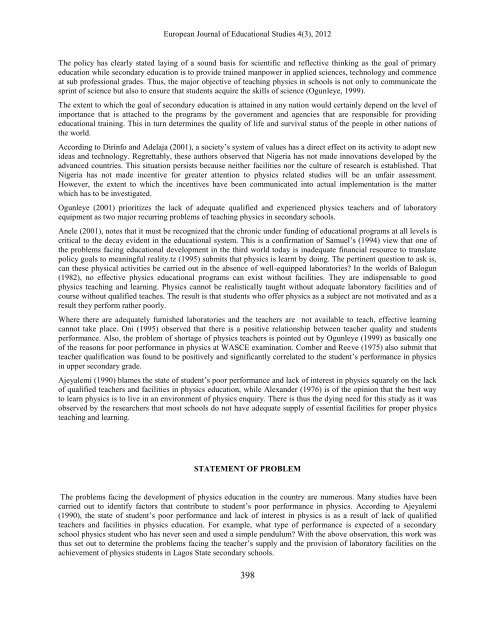Volume 4 Issue 3 (October 2012) - Ozean Publications
Volume 4 Issue 3 (October 2012) - Ozean Publications
Volume 4 Issue 3 (October 2012) - Ozean Publications
You also want an ePaper? Increase the reach of your titles
YUMPU automatically turns print PDFs into web optimized ePapers that Google loves.
European Journal of Educational Studies 4(3), <strong>2012</strong><br />
The policy has clearly stated laying of a sound basis for scientific and reflective thinking as the goal of primary<br />
education while secondary education is to provide trained manpower in applied sciences, technology and commence<br />
at sub professional grades. Thus, the major objective of teaching physics in schools is not only to communicate the<br />
sprint of science but also to ensure that students acquire the skills of science (Ogunleye, 1999).<br />
The extent to which the goal of secondary education is attained in any nation would certainly depend on the level of<br />
importance that is attached to the programs by the government and agencies that are responsible for providing<br />
educational training. This in turn determines the quality of life and survival status of the people in other nations of<br />
the world.<br />
According to Dirinfo and Adelaja (2001), a society’s system of values has a direct effect on its activity to adopt new<br />
ideas and technology. Regrettably, these authors observed that Nigeria has not made innovations developed by the<br />
advanced countries. This situation persists because neither facilities nor the culture of research is established. That<br />
Nigeria has not made incentive for greater attention to physics related studies will be an unfair assessment.<br />
However, the extent to which the incentives have been communicated into actual implementation is the matter<br />
which has to be investigated.<br />
Ogunleye (2001) prioritizes the lack of adequate qualified and experienced physics teachers and of laboratory<br />
equipment as two major recurring problems of teaching physics in secondary schools.<br />
Anele (2001), notes that it must be recognized that the chronic under funding of educational programs at all levels is<br />
critical to the decay evident in the educational system. This is a confirmation of Samuel’s (1994) view that one of<br />
the problems facing educational development in the third world today is inadequate financial resource to translate<br />
policy goals to meaningful reality.tz (1995) submits that physics is learnt by doing. The pertinent question to ask is,<br />
can these physical activities be carried out in the absence of well-equipped laboratories In the worlds of Balogun<br />
(1982), no effective physics educational programs can exist without facilities. They are indispensable to good<br />
physics teaching and learning. Physics cannot be realistically taught without adequate laboratory facilities and of<br />
course without qualified teaches. The result is that students who offer physics as a subject are not motivated and as a<br />
result they perform rather poorly.<br />
Where there are adequately furnished laboratories and the teachers are not available to teach, effective learning<br />
cannot take place. Oni (1995) observed that there is a positive relationship between teacher quality and students<br />
performance. Also, the problem of shortage of physics teachers is pointed out by Ogunleye (1999) as basically one<br />
of the reasons for poor performance in physics at WASCE examination. Comber and Reeve (1975) also submit that<br />
teacher qualification was found to be positively and significantly correlated to the student’s performance in physics<br />
in upper secondary grade.<br />
Ajeyalemi (1990) blames the state of student’s poor performance and lack of interest in physics squarely on the lack<br />
of qualified teachers and facilities in physics education, while Alexander (1976) is of the opinion that the best way<br />
to learn physics is to live in an environment of physics enquiry. There is thus the dying need for this study as it was<br />
observed by the researchers that most schools do not have adequate supply of essential facilities for proper physics<br />
teaching and learning.<br />
STATEMENT OF PROBLEM<br />
The problems facing the development of physics education in the country are numerous. Many studies have been<br />
carried out to identify factors that contribute to student’s poor performance in physics. According to Ajeyalemi<br />
(1990), the state of student’s poor performance and lack of interest in physics is as a result of lack of qualified<br />
teachers and facilities in physics education. For example, what type of performance is expected of a secondary<br />
school physics student who has never seen and used a simple pendulum With the above observation, this work was<br />
thus set out to determine the problems facing the teacher’s supply and the provision of laboratory facilities on the<br />
achievement of physics students in Lagos State secondary schools.<br />
398

















